Cancer – the scary scourge: Food abuse can cause it, smart food can prevent it
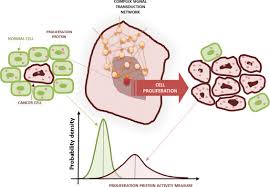 Cancer is autonomous, uncontrolled and limitless proliferation of cells at any location in the body that grows by attacking surrounding tissue and spreads (‘metastasizes’) to other tissues and organs. It can be caused by a large number of factors but generally, a change in the immediate, in-contact environment of any part of the body (e.g. nicotine and other tarry and incompletely oxidized chemicals reaching the lungs) is believed to be the primary cause. This can also be viewed as sustained exposure of body tissue to alien agents like abnormal heat, dust, virus, chemicals (benzene is a standard culprit for blood cancer) and even constant abrasion. Don’t keep irritating any part of the body with anything that it is not used to. It may be simpler to stick to nature.
Cancer is autonomous, uncontrolled and limitless proliferation of cells at any location in the body that grows by attacking surrounding tissue and spreads (‘metastasizes’) to other tissues and organs. It can be caused by a large number of factors but generally, a change in the immediate, in-contact environment of any part of the body (e.g. nicotine and other tarry and incompletely oxidized chemicals reaching the lungs) is believed to be the primary cause. This can also be viewed as sustained exposure of body tissue to alien agents like abnormal heat, dust, virus, chemicals (benzene is a standard culprit for blood cancer) and even constant abrasion. Don’t keep irritating any part of the body with anything that it is not used to. It may be simpler to stick to nature.
The role of diet in cancer: An interesting way of looking at our diet is that the input progressively reduces in quantity and nature during its transit thru our digestive system. The ‘reduction’ is by way of gradual absorption into the bloodstream and eventual ejection from the body. This leads to two obvious observations:
- Food cannot cause cancers, it is a physiological necessity. (Visit post nos. 2 and 3, Health, happiness, life and food: Parts I and II). But a number of previous posts have shown how its abuse can cause serious diseases. Cancers are one such and hence food can become one of the causes.
- The contact of the diet with our body is extremely limited, even superficial; with only the inner most lining of our digestive system. And it would be surprising, wouldn’t it, if nature did not ‘arrange’ for protection to this lining thru a protective coating? (Pharmacists will be reminded of glass-lined reactors for reaction mixtures that can harm the inner skin of the reactors and, in the process, spoil the integrity of the reaction mixture also.) That is indeed the case and the ulcers are a result of a breach in that protection. Note that –
– it would expose the tissue directly to the progressively digesting food with all the accompanying acidity/alkalinity, enzymes, digestion products, digestion aids (like bile salts in the first segment of the small intestine to help digest oils), water, undigestible fiber and, God forbid, alien chemicals entering thru food.
– 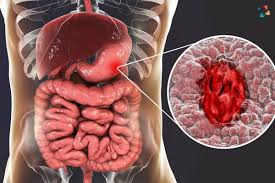 ulcers are not cancers, they can be a cause, though.
ulcers are not cancers, they can be a cause, though.
– the breach per se’ can be caused by many factors; you just steer clear of excessively fried spicy food, irregular meals, frequent/extended anxiety, overeating, alcohol, smoking, indiscriminate fasting and ignoring sharp, localized pain after eating and discolored stools.
– the alien chemicals – preservatives, antioxidants, crop protection chemicals, product management chemicals like anti-caking agents to prevent lumping up of the powders – can then directly access the tissue.
– To whatever extent these chemicals get absorbed into the blood, they gain access to all the tissues and organs where blood reaches.
(Ref post nos. 4 and 6, Industrial processed foods, Parts I and III. Also look forward to a planned post on synthetic antioxidants in our edible oils which are preservatives. As argued elsewhere, minimizing processing and the use of artificial preservatives – the antioxidants are just a ‘test case’ – though a sustained, world-wide campaign is overdue.)
It is thus only in very limited number of cases that diet can cause cancer directly. Generally, about one third of all cancers can be attributed to diet which strikingly means that something as essential as diet can be harmful if used thoughtlessly. Cancers can be rooted in many organs; blood, bones, skin, lungs, pancreas, colon, breasts, prostate gland are the common sites.
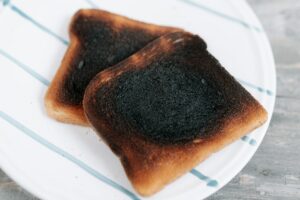 A few cases of ‘harmful food’: We have already discussed the havoc that oxidized food constituents – potentially all the foods that are heated for long periods in presence of air but in relative absence of water – can cause. Burnt food, we all know. (Post 16, Oxygen, food and life: Part II, The dark side of oxygen). Note that this puts a question mark over burnt toast and Indian style ‘roties’, caramel, ‘smoked’ food dishes and stale foods containing high IV refined oils like canola and soybean. (Refer the introduction to edible oils). There is nothing life-saving about them so, avoid; why play with fire?
A few cases of ‘harmful food’: We have already discussed the havoc that oxidized food constituents – potentially all the foods that are heated for long periods in presence of air but in relative absence of water – can cause. Burnt food, we all know. (Post 16, Oxygen, food and life: Part II, The dark side of oxygen). Note that this puts a question mark over burnt toast and Indian style ‘roties’, caramel, ‘smoked’ food dishes and stale foods containing high IV refined oils like canola and soybean. (Refer the introduction to edible oils). There is nothing life-saving about them so, avoid; why play with fire?
During such ‘oxidative’ cooking or processing, the constituents that are intrinsically vulnerable to oxidation can be damaged even with minor carelessness. The omega 3 fatty acids (of which the alpha linolenic acid is an ‘essential’ variety) are vulnerable and hence their inclusion in diet needs to be circumspect. Such oxygen-rich molecules and ‘free radicals’ floating about in the blood and sloshing against tissue is also ‘alien’ to those tissues. Also, obesity is a common precursor to cancer.
Food as a cancer-preventing factor: Cancer development has been divided into two stages:
- Initiation is the first, essential, one-time, irreversible or permanent event mediated by a cancer-causing agent or carcinogen which causes some mutation, like change in DNA structure of the cells. Sometimes, this is enough to develop into full-fledged cancer.
- Promotion is usually essential for development of cancer that finds distinct symptoms.
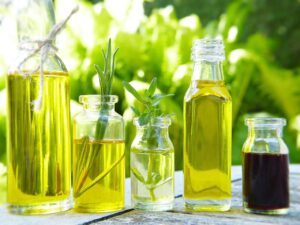 Dietary oils and fats, when partially oxidized, are common promoters. However, excessive fat consumption (which will, in any case lead to that all-damaging obesity) is likely to enhance cancer risk, especially of the colon and the breasts.
Dietary oils and fats, when partially oxidized, are common promoters. However, excessive fat consumption (which will, in any case lead to that all-damaging obesity) is likely to enhance cancer risk, especially of the colon and the breasts.
Precautions:
- Instead of splitting hair over which type of oil or fat may be the culprit, it is best to limit calories from that route to not exceed 30% of total calories. This is consistent with the recommendation of the American Cancer Society (and, interestingly, the American Heart Association) and the National Cancer Institute.
- Within this 30% limit, arrange omega 3 and 6 oils and saturated oils in proper proportion that we will talk about soon.
- Cook carefully at home as indicated above. As a corollary, prefer home-cooked food.
- Avoid fried bought-outs; they may contain oxidatively abused oils and even direct carcinogens like mineral oils. Processed packaged food is often loaded with preservatives which can be cumulatively harmful. There needs to be a campaign to redesign all our food processing (with even weeding out of some products altogether) for limiting of our artificial preservative intake.
- Exercise regularly, especially aerobically. Avoid obesity and diabetes. A positive attitude never harmed anyone.
 Consistently include dietary fiber-rich fruits and vegetables. They will automatically bring in natural anti-oxidants.
Consistently include dietary fiber-rich fruits and vegetables. They will automatically bring in natural anti-oxidants.- Be informed about common symptoms and, in the event of any suspicious outward ‘feeling’ or experience or change in daily routine, consult your doctor. Altered bowel habits, sudden unexplained loss of weight, sustained loss of appetite, a mysterious swelling, discoloration or mole, etc. are typical examples. Most cancers are curable if detected early.
Thus sustained precautions, alertness in noting unusual developments and immediate medical attention is the standard preventive triad.
Countering age as a cancer-causing factor: Aging is obviously inevitable and so are the changes coming with age. Muscle-tone reduces, metabolism slows down, blood lipid profile worsens, obesity tries to creep in, diabetes may creep in especially if genetically pre-disposed, digestion becomes weaker, ability and willingness for physical exertion takes a beating……..If you take the cumulative implications spread all over this entire blog, this looks like disaster.
 So we all know that age will catch up with us eventually, don’t we? They say that the best time to prepare for the bad times is the good times. So plant seeds of good health early. Stay physically and socially active. Develop hobbies. Contribute to society. Eat mindfully. Track BMI. Begin tracking blood lipid and glucose profile after crossing 40. Your physician will draw out a time-chart for the PSA (Prostate-Specific Antigen) tracking, liver profile, Cervical and other G & O cancers scanning, Arthritis profile, CVD profile and many more. Presume nothing.
So we all know that age will catch up with us eventually, don’t we? They say that the best time to prepare for the bad times is the good times. So plant seeds of good health early. Stay physically and socially active. Develop hobbies. Contribute to society. Eat mindfully. Track BMI. Begin tracking blood lipid and glucose profile after crossing 40. Your physician will draw out a time-chart for the PSA (Prostate-Specific Antigen) tracking, liver profile, Cervical and other G & O cancers scanning, Arthritis profile, CVD profile and many more. Presume nothing.
Have food on your side by understanding what it can do for you; understand when it can cause harm (revisit all the previous posts). Life is beautiful; maintaining it is our responsibility. Rewards of care are enormous. Don’t kill the goose laying golden eggs. Prevention is better than cure. If struck by disease, perservere and be patient. Most things can be cured. Happy living with food on your side.
Now, a very useful diversion.
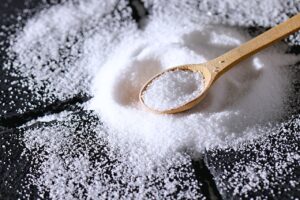 We have noted how salt imparts salty taste while also enhancing flavor of savory dishes, how it is difficult to avoid salt in cooking and in bought-outs and how it is harmful. You know that your daal or subji comes alive when missing salt is added. The burst of salty taste on mouthing a potato chip or a salty biscuit is a delight. Make no mistake about it; we all consume more salt than is good for us and salt reduction should rate the same importance as mindful eating and physical exercise. (Ref mainly Post 3. Health, happiness, life and food: Part II, Defining food and using it smartly and Post 12. Popular processed food categories: An overview, And some practical adopt-avoid advice.)
We have noted how salt imparts salty taste while also enhancing flavor of savory dishes, how it is difficult to avoid salt in cooking and in bought-outs and how it is harmful. You know that your daal or subji comes alive when missing salt is added. The burst of salty taste on mouthing a potato chip or a salty biscuit is a delight. Make no mistake about it; we all consume more salt than is good for us and salt reduction should rate the same importance as mindful eating and physical exercise. (Ref mainly Post 3. Health, happiness, life and food: Part II, Defining food and using it smartly and Post 12. Popular processed food categories: An overview, And some practical adopt-avoid advice.)
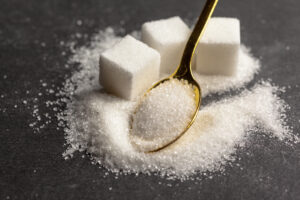 We have a good idea about sugar – the other main cooking ingredient and processed food component. The recent posts on Diabetes have been pretty exhaustive in describing it role in our health. A less noticed fact: sugar also contributes to texture of food. Your chyavanpraash would be less gooey, your murabba less richly viscous, your solid sweets less firm, your rabdi less richly thick, your biscuits less sweetly clingy to the tongue without it. At a GI of 65 it is not alarming but a plateful of sweets or a few bowls of Gujarati style doodhpaak would have alarming GL for a pre-diabetic.
We have a good idea about sugar – the other main cooking ingredient and processed food component. The recent posts on Diabetes have been pretty exhaustive in describing it role in our health. A less noticed fact: sugar also contributes to texture of food. Your chyavanpraash would be less gooey, your murabba less richly viscous, your solid sweets less firm, your rabdi less richly thick, your biscuits less sweetly clingy to the tongue without it. At a GI of 65 it is not alarming but a plateful of sweets or a few bowls of Gujarati style doodhpaak would have alarming GL for a pre-diabetic.
Which brings us to a multifaceted wonder called edible or cooking oils.
 Preview of next 11 posts – smart consumption of oils and ghee: From experience, anecdotal evidence and judgment, we believe that answers to the following questions from a partial list would be of great help in allaying persistent doubts and apprehensions about edible oil. This is meant to be a serious empowerment.
Preview of next 11 posts – smart consumption of oils and ghee: From experience, anecdotal evidence and judgment, we believe that answers to the following questions from a partial list would be of great help in allaying persistent doubts and apprehensions about edible oil. This is meant to be a serious empowerment.
- In how many ways do the oils enter our body.
- How do we use oils in various modes of cooking, what is expected from the cooking oils in each mode and how do they themselves change in these cooking processes.
- How do we select ‘practically best’ oils for each mode of cooking so that the oils fulfill their nutritional roles and this includes avoiding anti-nutritional issues like the cooked food becoming harmful. This is particularly important because, in India, most of oil/fat enters body as part of cooked/processed food and amounts of butter, ghee and some unrefined oils consumed as such are a very small fraction of the total consumption.
- How much of oils i.e. what quantity is ‘recommended’ for individuals in a family – the ideal cohort to monitor consumption? How to arrive at what quantity consumption is actually happening in a family at present? How to migrate towards ‘recommended consumption’ and keep track?
- What are ‘vanaspati’, hydrogenated oils, trans fatty acids, saturated fatty acids, unsaturated fatty acids (and among them, MUFA, PUFA and essential fatty acids) and why has vanaspati (as a product of hydrogenation) become tainted? What is the truth? Should hydrogenation of oils be abandoned irreversibly forever?
- What exactly is ‘desi’ or ‘shuddha’ ghee? Is it beneficial? Harmful? How best to exploit its delicious appeal?
For your convenience, we haves assigned the next post to a preview of the next 9 posts so that you can locate your required answers conveniently. Let’s ride together!
Next Post:
A preview of the next 11 posts on edible oils
Everything you ever wanted to know and where to find it
Visit Disclaimer
2 thoughts on “Cancer – the scary scourge: Food abuse can cause it, smart food can prevent it ”
I truly appreciate this post. I’ve been looking everywhere for this! Thank goodness I found it on Bing. You’ve made my day! Thx again!
you’ve an important weblog here! would you like to make some invite posts on my weblog?